Of all hernia types – sports hernias are probably one of the most difficult to understand. The most important aspect of sports hernias is that it is not truly a ‘hernia’. A hernia by definition is a hole in the muscle through which fat and/or intestines push through. However, in a sports hernia, there is a tear in the muscle,but no fat or intestine pushing through. The damaged muscle is what causes the pain and other symptoms.
Second, there are NO consensus statements about exactly what a sports hernia is, what causes it,and how to repair it! Any hernia surgeon that claims to know everything about sports hernias isn’t being honest with him or herself, and likely their patients. Dr. Harris frequently sees patients with chronic groin pain, many of which are referred from Sports Medicine Physicians in Southern California and beyond. Below is what we believe at California Hernia Specialists and a small sample of photos we have taken during our sports hernia repairs.
What is a Sports Hernia?
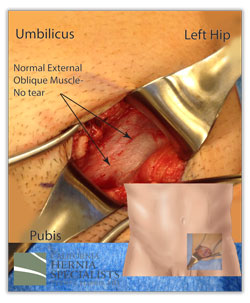
We believe that a sports hernia is a chronic tear or weakness in one of the muscle layers in and around the groin. This tear is often seen in athletes who have very strong thigh and abdominal muscles which pull against each other in the groin area. With this constant stress pulling down in the thigh, and up in the abdomen, a tear can occur in a layer of muscle in the groin area. This tear is what most describe as a ‘sports hernia’.
Again, a sports hernia isn’t a true hernia in the strictest sense, since there is no fat or intestine pushing through the torn muscle. The muscle tear frequently causes NO pain with sitting, standing or other non-intense activities. However, the minute a patient begins athletic activity or anytime the groin is used, the pain immediately returns. What usually differentiates a sports hernia from just a pulled muscle is the chronic nature of the injury; sports hernias do not improve with rest since the tear never heals itself.
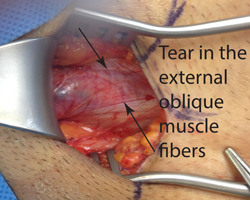
We often see these injuries in athletes who play soccer, hockey, football, and other sports which develop strong thigh muscles and abdominal muscles. Sometimes the symptoms of a sports hernia can persist for many years before a patient ultimately finds treatment, or the symptoms become severe enough for that patient to seek treatment.
Sports Hernia Observations in Our Practice
The following are general observations of patients in our practice with sports hernias:
- Sports hernias are chronic in nature, usually present for over 6 months
- Most patients have already gone through at least one rest cycle of 1-3 months depending on their level of activity. This rest period improves the pain, but immediately after resuming activities, the pain returns
- The pain is usually focused and fixed in one specific area, not generalized to the abdomen, groin, and leg. This is due to the fact that a sports hernia is an injury to one specific muscle, which is the trigger for the pain. It doesn’t tend to be diffuse in nature. Patients can often pinpoint their pain with one finger.
- Patients have often gone through several cycles of Physical Therapy with no improvement.
- The location of pain is usually upper thigh (adductor), the groin itself (external oblique or inguinal floor) or lower abdomen (rectus muscle insertion on the pubic bone).
- Sports hernias are very rare in non-active patient, and even uncommon in non-elite level athletes.
Hernia Types – Sports -How Do We Repair Them?
We believe that since a sports hernia initiates from a tear or a weakened layer of muscle fibers, simply sewing this muscle closed could lead to recurrences. The muscle fibers tear because of a reason; the muscle is weak or over used. Thus, we feel the muscle fibers need to be reinforced to help prevent them from tearing again in the future. Therefore we perform a mesh repair similar to what would be done during an inguinal hernia repair.
The location of the pain, as well as the findings of any preoperative imaging helps guide our surgical approach – adductor, external oblique, inguinal floor or rectus abdominus.
For external oblique injuries, open surgery is recommeneded. The nerves that run through the inguinal canal (ilio-inguinal and ilio-hypogastric) must be examined for trauma and scar formation. Often during years of repeated injury the nerves can become permanently injured. In these cases, the nerves will be purposefully cut to help prevent continued chronic pain after the surgery. These nerves DO NOT control any muscle function or other male functions. They are simply cutaneous (sensation) nerves of the groin which, when removed, results in some minimal numbness of the groin (not of the male organs).
Patients with pain at the inguinal floor or the rectus muscle, we usually recommend laparoscopic surgery since those muscle layers are more easily visualized and repaired from a ‘posterior’ approach.
Patients with adductor injuries are either treated by sports medicine physicians with injections, or as a last resort, complete transection of the adductor bundle.
Actual Case Photos and Videos
Normal Patient
The photo below was taken on a patient during a normal inguinal hernia repair. This patient did not have a sports hernia type injury and thus his outer layer of muscle, the external oblique, is completely normal. There is no separation of the muscle fibers since the hernia is on the inside layers of muscle.
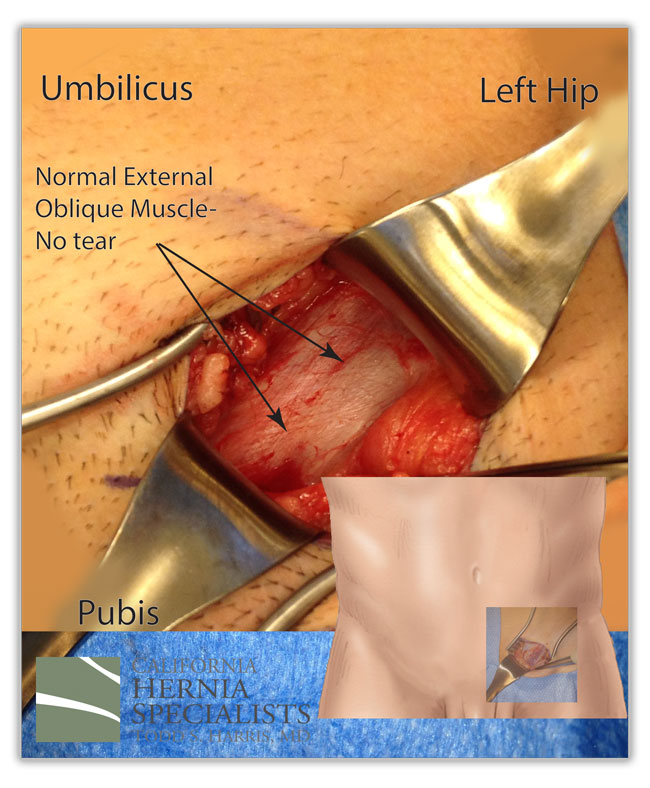
1. 54yo Triathlete
This patient had almost 6 years of left groin pain. He was an avid athlete and had felt a ‘tear’ in his left groin. Ultrasounds and CT scans failed to show an inguinal hernia however his pain continued. Over the years, the pain got worse and traveled further up and down his groin.
Ultimately he sought help at California Hernia Specialists where a tentative diagnosis of a sports hernia was made based on his symptoms. No inguinal hernia could be felt on examination before surgery.
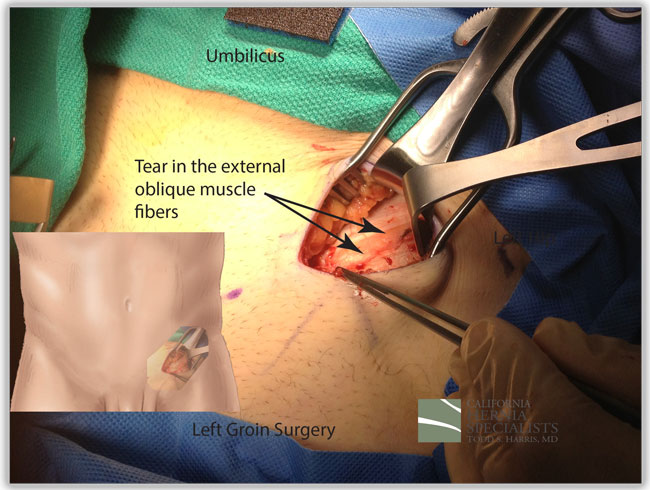
The intra-operative photo above shows an obvious tear in the external oblique, which is the outer layer of muscle in the groin. In the photo, the yellow fat from underneath the muscle is seen between two edges of the white muscle fascia which have torn. The tear was about 4 inches long, and about a0.5 inch wide. This was repaired with a mesh under the tear, and by closing the tear with sutures.
2. Marathon runner
The photo below is from a 50 year old patient showing the same tear in the external oblique. He was a multiple marathon runner and a competitive triathlete. During his cycling and running he would have disabling pain in the left groin. After resting for several months, the pain returned without improvement.
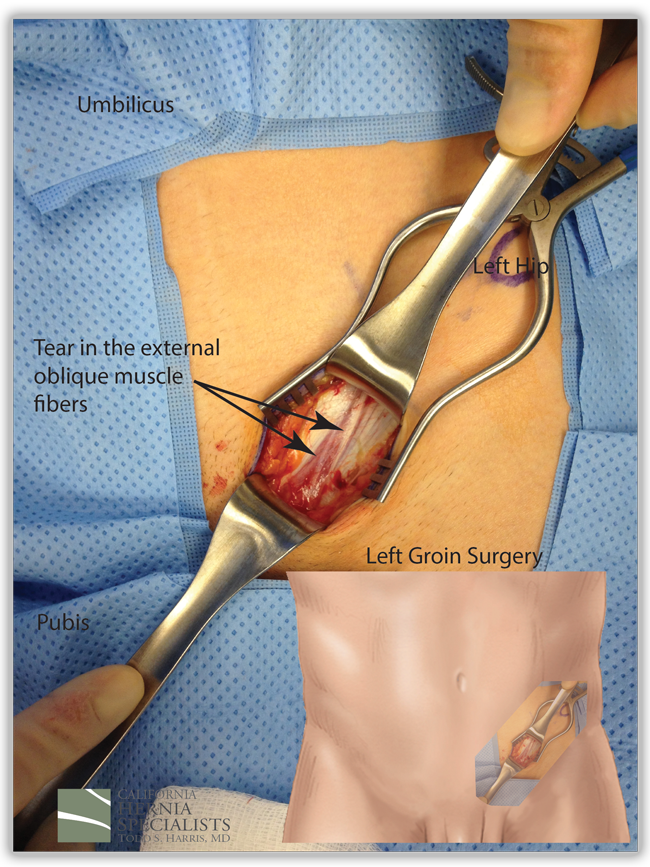
3. Hockey player from Alaska
Again, the patient shown below was a hockey player in Alaska and was an avid skier. Over the past 6 year she developed worsening pain in the left groin. This increased to the point that even with the light activity he would develop acute left groin pain. He presented to California Hernia Specialists for evaluation and treatment.
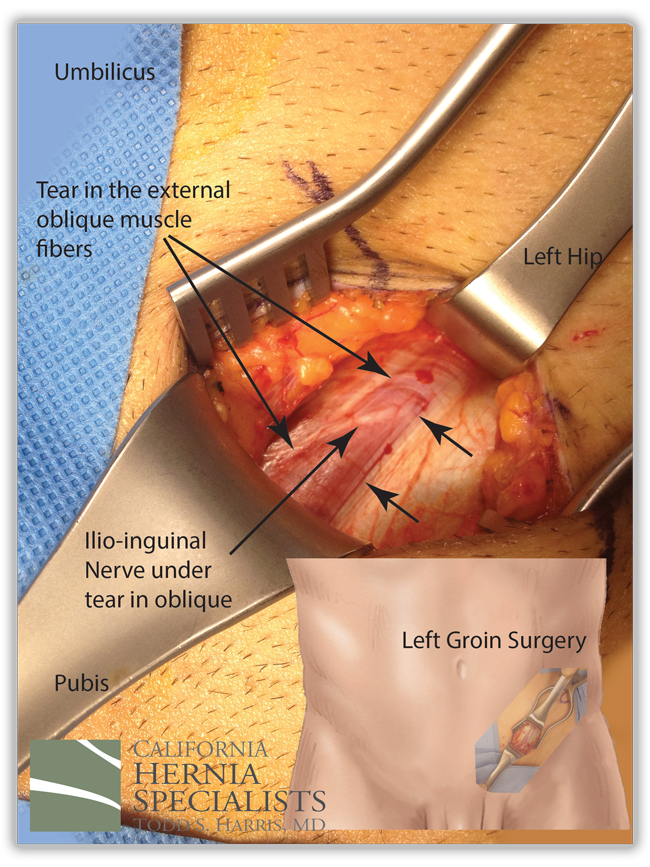
4. 19yo college soccer player
This patient was a 19yo college soccer player who had been treated for a groin strain for over a year.His pain would return almost immediately after resuming soccer but had no pain at rest. Despite months of physical therapy and sports medicine treatments, he continued to have pain. His parents contacted California Hernia Specialists to have him evaluated and treated.
On examination, his left groin was extremely tender with pressure. This, along with his history,suggested the diagnosis of a left groin sports hernia. He underwent open exploration of the groin which demonstrated a clear tear in the external oblique muscle. This tear was repaired using a small mesh under the muscle, and the nerve that was damaged from the tear was treated.
This first image shows the large tear in the muscle fibers of the external oblique. The pink/purple area should be a healthy white color just like the edges of the tear. The retractor is helping expose the lower end of the external oblique.
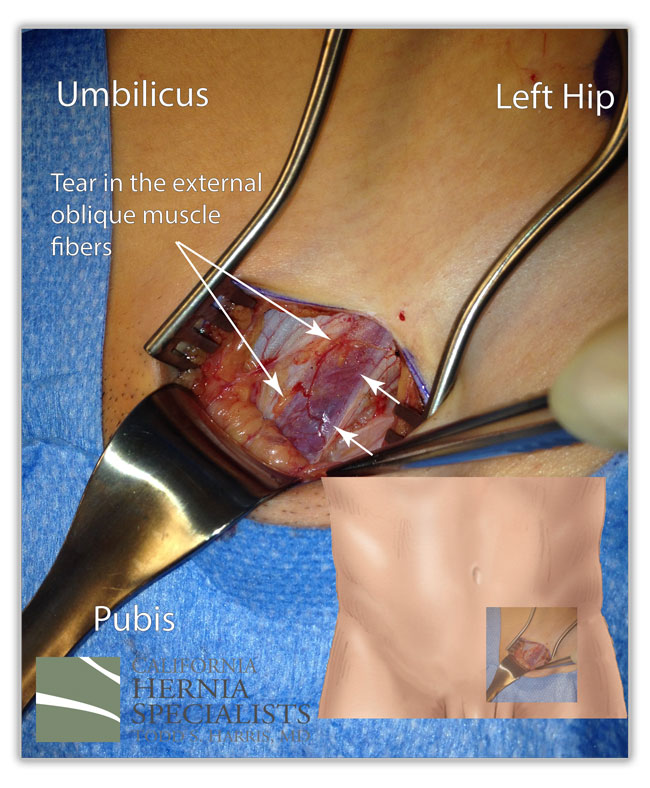
After surgery the patient recovered for 6 weeks during the summer off season. He started training in the late summer and went on to have a pain free fall season at college.
Laparoscopic Sports Hernia Repairs?
Laparoscopic repair is usually recommended in sports hernias affecting the inguinal floor or rectus muscle since we believe that the cause of this type of sports hernia is a tear in the inner layer of the muscle in the groin (see above). Laparoscopic surgery exposes those inner layers of muscle extremely well allowing us to repair the inner layer of muscles.
Laparoscopic Sports Hernia Repair
Dr. Harris performing a laparoscopic bilateral sports hernia repairCauses of groin pain:
Sports hernias are more a diagnosis of exclusion, when all other causes of groin pain are ruled out. Since most tests are normal during work up for a sports hernia, they can be very difficult to diagnose. Hip pain, strained or pulled muscles, an actual inguinal hernia, are among things which are the most common causes of groin pain.
Occasionally an MRI can show areas of abnormality around the pubic bone in the groin. These abnormalities scan help indicate a muscle injury, but again are sometime very vague and are not always helpful.














